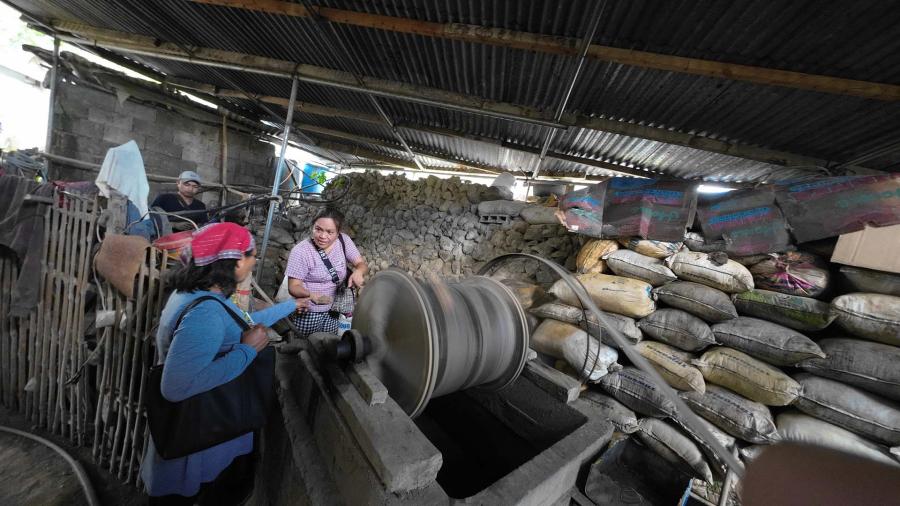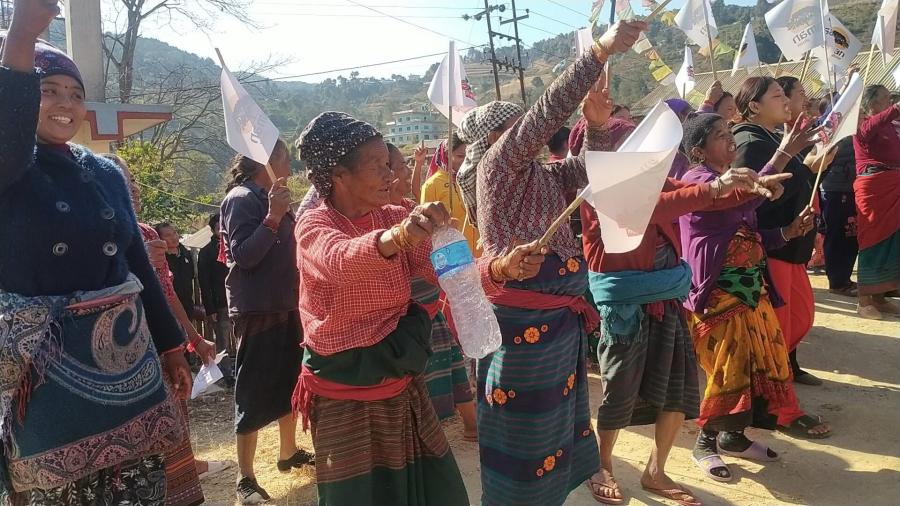
By Dev Kumar Sunuwar (CS Staff)
Following a successful advocacy campaign by the Indigenous Community Radio Network (ICRN), a grant partner of Cultural Survival’s Indigenous Community Media Fund, along with other media organizations in Nepal, the Nepali government has decided to hold back its plans to present new media legislation to the federal Parliament for approval.
The government was in the final stage of preparation of three new media bills to be considered at Parliament, but the process was interrupted by massive lobbying efforts that included a 17-point of demand position paper to ensure meaningful consultation and create a legal environment to sustain and flourish Indigenous media in Nepal.
“Our lawmaking process lacks proper consultations with stakeholders; media laws and policies are no different. Therefore, ICRN carried out lobbying and advocacy works to craft Indigenous media-friendly laws across Nepal,” said Jagat Man Lama Dong, Chairperson of ICRN.

Schedule 8 of the Constitution of Nepal (2015) gives local government the authority to manage and operate FM radio up to 100-watt capacity, whereas the provincial government has authority to regulate media across the province, including FM radio up to 500-watt capacity, and cable television as per Schedule 7 of the Constitution. The authority to distribute radio frequencies and the monitoring and regulation of satellite TV channels and national newspapers lies with the federal government, as per Schedule 5.
The provincial and local governments are following the federal government’s path of formulating media policies and laws according to the jurisdiction given by the Constitution. Some have already prepared the law with provisions empowering authorities to stop the broadcast of local FM radio.
The Constitution has far-reaching provisions in regards to Indigenous Peoples’ right to media. Article 17 (2) guarantees Freedom of Opinion and Expression, while Article 19 guarantees the Right to Communication, restricting authority from “prior censorship or publication and broadcasting or information dissemination or printing of any news items, editorial, article, features, or other reading materials or the use of audiovisual material by any medium, including electronic publication, broadcasting, and printing.”

Article 29 provisions the Right to Information, which reads, “every citizen shall have the right to seek information on any matters of concern to her/him or the public.” However, the article lacks ensure Indigenous Peoples’ “right to information in the language they speak and understand. Likewise, Article 32 guarantees the Right to Language and Culture and reads, “each person and community shall have the right to use their language.”
The Ministry of Communication and Information Technology has prepared a Mass Communication Bill for consideration in Federal Parliament. Once endorsed, it will replace the Press and Publication Act of 1991, Working Journalist Act of 1994, and National Broadcasting Act of 1992, which jointly govern the mass media sectors of the press, radio, and television.
The new bill includes harsh provisions including fines and sentencing of journalists up to 15 years of prison if found publishing or broadcasting content deemed to be against the national unity, sovereignty, and territorial integrity.

In many cases, Indigenous journalists, media practitioners, and communicators have had to work under threats and intimidation and regularly experience violence perpetrated by government authorities. Many Indigenous journalists live in fear of violence and criminalization simply for exercising their right to freedom of expression while reporting on divisive issues relating to land rights, social movement, environmental protections, human rights, and local politics.
The Ministry of Communication and Information Technology has already begun consideration of two controversial bills in the early 2020 session of parliament: the Information Technology Management Bill (also known as the IT Bill) and the Media Council Bill.
The Media Council Bill grants power to impose fines of up to 1,000,000 Nepalese rupees if journalists are found guilty of libel and defamation, which will also be punishable under the criminal code.
The IT Bill, which is said to be the most comprehensive bill, replaces the existing Electronic Transactions Act of 2008 and gives broad powers to authorities to surveil personal data and potentially block social media and messaging platforms such as Facebook, Twitter, Instagram, Viber, and Whatsapp. The legislation also requires Facebook and Google to set up their offices and register in Nepal so that they can be held accountable and pay taxes on the money they make from Nepali users.
The IT Bill includes provisions of imprisonment for individuals of up to five years and fines of up to 1,500,000 NPR for posting online content “to sexually harass, bully, or deface others.” Up to now, the government has been using the Electronic Transaction Act to arrest and take action against people whose social media posts were deemed improper by the authorities.

In 2016, to be consistent with the new Constitution, the government adopted the National Mass Communication Policy aimed at ensuring a fair, responsible, and accountable mass communication sector and to create an equitable society based on proportional inclusion and participation; to protect free communication media; and equitable development of all kinds of mass communication media and access to information. However, the policy does not explicitly recognize Indigenous media.
Recognizing the importance of the rights of Indigenous Peoples to establish their own media and free expression and access to informaiton in their languages to safeguard their culture, identity and protect their knowledge and information concerning them, Article 16 (1) of the United Nations Declaration on the Rights of Indigenous Peoples (UNDRIP), states, “Indigenous Peoples have the right to establish their own media in their own languages and to have access to all forms of non-indigenous media without discrimination. Similarly, the puting the obligation on States, as parties to the Declaration, the Article 16 (2) of UNDRIP states, “States shall take necessary measures to ensure that media duly reflect Indigenous cultural diversity and States, without prejudice to ensuring full freedom of expression, should encourage privately owned media to adequately reflect indigenos cultural diversity.”
Indigenous Peoples comprise 36 percent of Nepal’s total population of 26,000,000. However, in Nepal, there are only a few media outlets that provide content in Indigenous languages and from the perspective of Indigenous Peoples. Nepali media is still overwhelmingly controlled by the members of the dominant social groups, both in terms of ownership and content production.
The major language used in the media is Nepali. At present, there are 116 television channels and 740 FM radio stations that have obtained a broadcast license, with the majority of these in operation. There are a total 7,559 newspapers and magazines registered, including 735 daily newspapers.
Of all newspapers published in Nepal, 93 percent are published in non-Indigenous languages. Public media broadcasting via Nepal Television, Radio Nepal, and Gorkhapatra (the national daily newspaper) merely provide Nepali news translated into Indigenous languages with a relatively higher number of speakers, and the content does not reflect the cultures, concerns, and voices of Indigenous Peoples themselves. According to the 2011 Census, Nepal has 126 castes and ethnic groups who speak as many as 123 languages, of which 90 percent, almost 117 languages are spoken by Indigenous Peoples.
Despite frequent reassurance by the government that public media would become more inclusive and participatory, a recent study conducted by Inclusive Media Campaign on the staffs of four government-owned media houses (Rastriya Samachar Samiti, Gorkhapatra Corporation, Radio Nepal, and Nepal Television) showed only 11 percent participation of Indigenous Peoples at the policymaking level in government-owned media.
The few media outlets that are owned and operated by Indigenous people lack funding and support from the government. Indigenous Peoples’ lack of control over their own forms of media, in Indigenous languages, has hindered Indigenous Peoples’ right to access, participate in, and have voice in Nepali society. It deprives them of their right to information, freedom of expression reflecting their cultural and lingual diversity, and right to communication in Indigenous languages.
In order to lobby government to end legal disparities to ensure freedom of expression of Indigenous Peoples, Indigenous Community Radio Network (ICRN), in partnership with Cultural Survival and World Association for Christian Communication (WACC), organized series of interaction programs among the local journalists, Indigenous Peoples Organizations, and media organizations. ICRN then produced a report including in-depth analysis of gaps in the existing media policies, Constitution, Acts, and regulations of Nepal for Indigenous Peoples- friendly media to flourish and ICRN also produced a position paper consisting of 17-point recommendations and handed over to the government officials and policymakers at the local, provincial and federal level.
One of major demands made by ICRN was to ensure meaningful participation of stakeholders including Indigenous journalists and representatives from Indigenous media organizations in the making of media laws at the federal, provincial, and local levels and give special recognition to Indigenous media in order to sustain them, as set forth in international law.
During programs organized at the national level, as well as in Bagmati Province and Gandagi Province, the majority of participants demanded that the government create an environment to enable legal recognition of Indigenous-led media as “Indigenous Media,” and to take effective measures to sustain media guaranteed by the UN Declaration on the Rights of Indigenous Peoples.
Ganga Rai, an Indigenous journalist from Udayapur, emphasized the need to categorize Indigenous-led media specifically as "Indigenous Media," “Unless there are fair procedures in regards to the distribution of advertisements and dissemination of information, and until the government recognizes Indigenous-led media by the government distinctively, there is no way that Indigenous-led media can be sustained and flourish in Nepal,” Rai said.
Upon receiving the ICRN position paper and study on discriminatory provisions in existing media policies and laws for Indigenous Peoples, the Minister of Communication and Information Technology, Parbat Gurung said, “I express commitment that [Indigenous Peoples] be consulted properly among the concerned stakeholders before [the new legislation is considered] at Parliament for approval.” He added, “the recommendations of ICRN are relevant, [and] will be included in the bills.”
Chief Minister of Gandaki Province in western Nepal, Prithivi Subba Gurung, said, “The provincial government is in the process of making media policies and laws [that] will include the recommendations made by ICRN. The study and demands made by ICRN are relevant and timely.”
Of all seven provinces, Bagmati Province has been the quickest in adopting media law. It has endorsed the Bagmati Province Mass Media Management Act of 2018, which does not contain a provision to promote Indigenous language-based or Indigenous-led media. Talking to the ICRN team during the position paper handing ceremony, Press Registrar, Rewati Prasad Sapkota, said, “though many of the demands made by ICRN are included in media laws endorsed by Bagmati Province, some provisions still need amendments. This position paper and study submitted by ICRN will be taken as reference during the amendment process.”
Acknowledging the ICRN’s effort to draw the attention of local government, Mayor of Triyuga municipality, Baldev Chaudhary, expressed the commitment that the local government will give special recognition to Indigenous media.
Cultural Survival’s Indigenous Community Media Fund provides opportunities for international Indigenous radio stations to strengthen their broadcast infrastructure and systems, and creates training opportunities in journalism, broadcasting, audio editing, technical skills and more to Indigenous community radio journalists around the world. In 2020, the Indigenous Community Media Fund supported 35 media projects in 8 countries, totaling $214,000.


